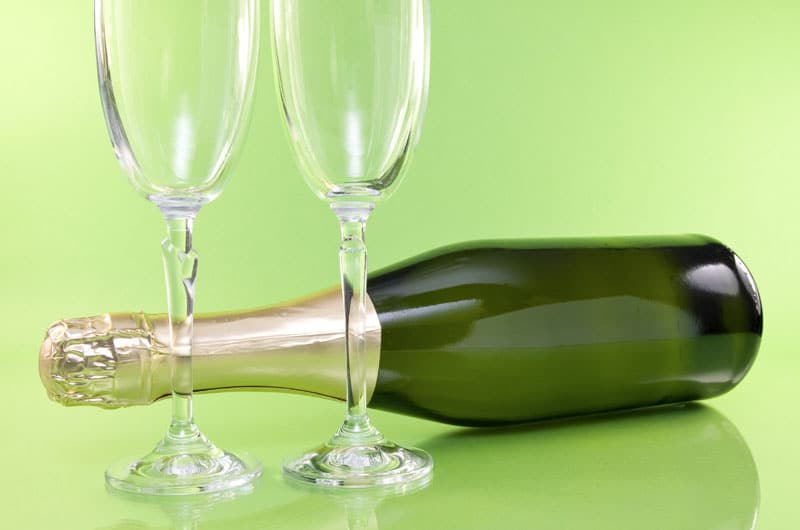by Jenny Benzie, Advanced Sommelier + Certified Wine Educator, Proprietress of Épernay Wine & Spirits
Even if you’re not much of a sparkling wine drinker, there are some special occasions that call for more than just the usual libations of a Dark & Stormy or Nantucket Mule. There’s no better way to liven up your soiree than by serving something that sparkles and shines.
The first key point to remember even before you think about popping that cork, is that the bottle must be thoroughly chilled. Glass on a Champagne bottle is almost twice as thick as a regular wine bottle due to the gas pressure inside. Therefore, it takes longer for a bubbly bottle to achieve its optimal temperature than it does for other wines bottles. The proper temperature for serving Champagne or other sparkling wines is from 43 to 48 degrees F. There’s no thermometer for wine in a bottle, so you won’t know the temperature of what’s inside until you open it. The best way to ensure that your bottle is chilled to the ideal temperature is to put it in a fridge set in the proper temperature range and can be monitored for at least four hours before opening. Just because the bottle feels chilled to the touch does not mean that the juice inside has had sufficient time to cool.
A method to quickly chill the bottle is to submerge it in an ice bath comprised of half ice and half water, sprinkled with a generous amount of kosher salt. You are probably wondering what affect the kosher salt has on this whole process. First of all, ocean water freezes just like regular freshwater, but at a lower temperature. By using salt in your chilling process, the temperature of the water will actually go below the usual 32 degrees F freezing temperature. The other benefit to using kosher salt is that is a larger, more granular salt than regular table salt. Therefore, it does not dissolve as quickly as table salt and assists in bringing the water to a colder temperature. Note that salt and ice alone will not do the trick, as they must first be combined with water in order to start the chilling process.
Once your sparkling treat has been properly cooled, it’s time to open it. There’s a proper technique for this as well; you don’t want to risk shooting the cork across the room and cause bodily harm—nor do you want the contents of the bottle spewing out all over the place, leaving you with less of it to drink. Therefore, it is important not to be careless in how you extract the cork from a bottle that is under a significant amount of pressure.
First: have a dry hand towel at the ready. Next: remove the foil that covers the cork. Some sparkling wines have a small tab that you can pull to easily peel off a thin line around the circumference of the foil, allowing you to remove the top portion. Otherwise, use the knife on a wine opener in order to cut and remove the foil, just as you would for a regular wine bottle. Once the foil has been removed, cover the cage with your trusty hand towel. Next, hold the bottle at a 45 degree angle (NOT straight up and down—you could potentially poke your eye out). Using one hand, cover and hold the top of the bottle with the towel. Use the other hand to untwist the wire on the cage, called the muselet, that covers the cork. This can usually be achieved in fourand- one-half twists (go ahead and test me!), but do not remove the cage. Just loosen the cage enough so that it can glide over the lip of the bottle with no obstruction.
At this point, keep your hand with the towel covering the top, and grip the bottom of the bottle with your opposite hand, still at the slanted angle. Twist the bottle, not the cork, in order to open it, all the while holding your other hand over the cage, cork, and towel. This method enables you to have more control over the bottle and the pressure that is exerted when the cork finally emerges. Unlike what you see in the movies, the removal of the cork should sound like a whisper and be almost inaudible to the anxiously awaiting, thirsty crowd.
After you have safely extracted the cork, it is now time to pour around for everyone. When serving sparkling wine, it is recommended to hold the glass by the stem and tilt it at a slight angle. You will then slowly (at a turtle’s pace) pour the bubbly down the side of the glass until it is about half way full. At this time, you can then tilt the glass to its upright position and finish pouring. It is not considered proper service to pour quickly, have to stop midstream in order for the bubbles to dissipate, then restart pouring more into the glass. Never fill a Champagne glass to the rim, as the effervescence needs some room at the top in order to do its sparkling business.
With these handy details on how to perform bona fide Champagne service, you will have no need to be intimidated next time you’re asked to do the honors.



